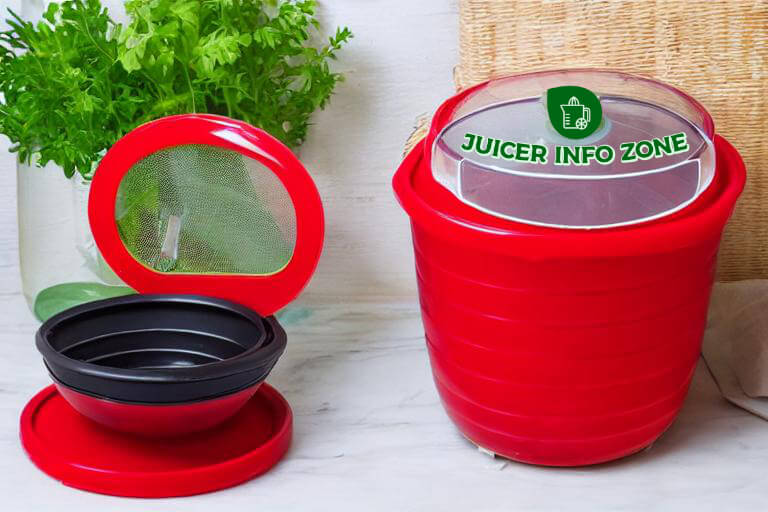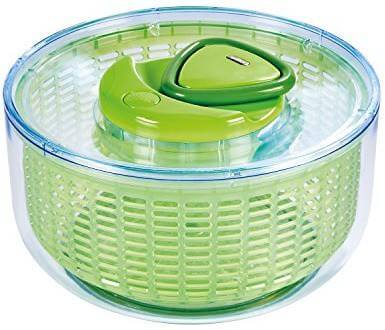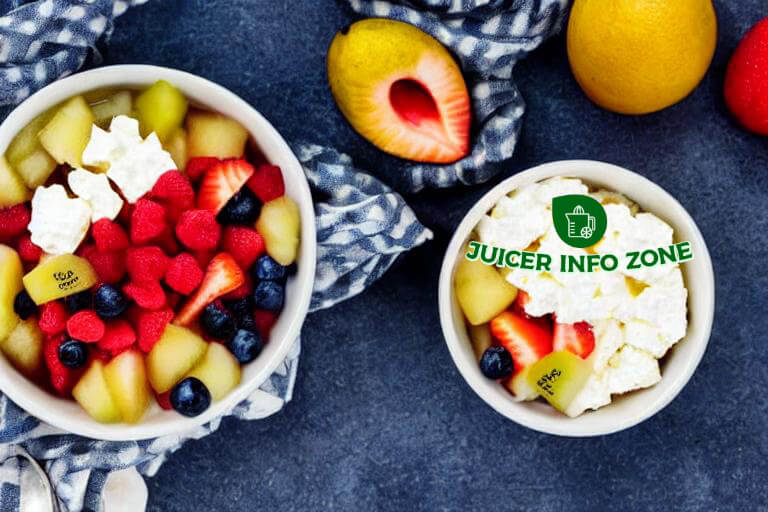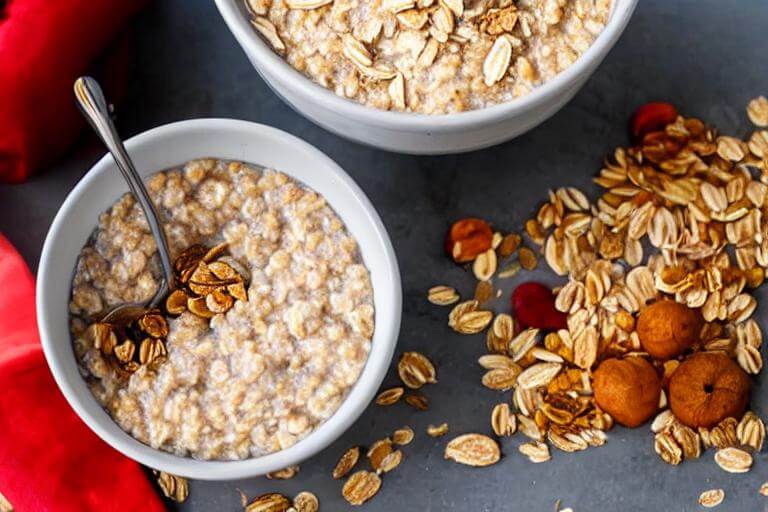Salad Spinners: Spin Your Salad Healthy

Most kitchen gadgets are purchased on impulse, used once or twice for the novelty of them, and then quickly buried in a cabinet or drawer.
You know that drawer. It’s basically the land of misfit kitchen gadgets filled with everything from fancy garlic peelers, apple corers, electric can openers to the Miracle Chef veggie chopper.
But one addition to your kitchen which won’t be banished to the gadget cabinet is a good salad spinner. And if you don’t own one, it’s time to change that. Prepping healthy salads economically and quickly is simple and easy with a good spinner on hand.
What is a Salad Spinner?

The best way to describe a salad spinner is to think of it as a colander inside a bowl that can spin around.
You place chopped salad greens into the inner bowl, rinse them with cold water a few times, drain out the water and then spin the greens around inside the contraption. The centrifugal force of the spinning action sucks the remaining water out of the salad, leaving it dry and crisp.
Salad spinners use a variety of different mechanisms to actually propel the inner bowl around, from simple circular hand-cranks, to plungers, to pull-strings to ratchets. The only real difference between them is how easily they spin, durability, and most of all, which method extracts the most water out of the salad.
Why Would You Want To Spin Your Salad?
The advantage of a good salad spinner is that it allows you to easily wash, drain and crisp large amounts of salad greens.
We all know the health benefits of eating plenty of fresh greens and lettuce, so a salad spinner helps you more easily prepare salads, and keep plenty of greens on hand to throw together dinner or lunch salads across the week.
Spinning Your Own Salads Costs Less
While pre-packaged salad greens that you buy at the store are convenient, they aren’t particularly economical. So if eating healthy on a budget is a concern for you, it makes sense to spend 10 minutes in the kitchen rinsing and bagging your own salad.
Spinning and crisping your own salad is much more economical than buying the pre-rinsed, pre-bagged salad mixtures you find in the refrigerated produce section. A bag of Dole pre-packaged romaine lettuce can cost up to $4, but you could prepare almost four times that amount of salad yourself at home with a salad spinner, all for the same cost.
The salad will also be fresher, since you won’t be eating soggy greens that sat in a bag for a week. You can also customize your salad blends, adding baby spinach, leaf lettuce, romaine, kale, whatever.
You’ll also have a tendency to eat more healthy greens and salads, because you’ll always have a bag of pre-rinsed, pre-spun salad on hand in the fridge. And while I can’t quantify the amount of calories you’ll burn spinning salad, I can say that it’s more than if you bought them pre-bagged.
Getting the Salad Dry: The Secret to Salad Spinning

The secret to successfully using a salad spinner is to get the lettuce or greens as dry as possible before bagging it in gallon ziplock bags or a sealable crisper.
This is where the salad spinner that you choose to buy matters.
The main goal of a good salad spinner is to extract as much water from the lettuce and greens as possible. If the spinner is too flimsy and can’t spin the salad around with enough force to suck the water out, you’re going to end up with a brown, wilted mess within a few days of storage.
Also, the drier the greens, the more easily they will take up the healthy dressings and vinaigrettes you put on them. Water on the leaves repels the oil in the dressing (remember, even healthy oil and water don’t mix), which will interfere with the texture of the dressing and salad.
So drier is always better.
Choosing and Buying The Best Salad Spinner
When you shop for the best salad spinner for your needs, get one that is sturdy and free of too many gimmicks like “pull” or “zip” strings that are supposed to spin the inner bowl around. If you choose the right salad spinner the first time, you’ll probably never have to buy another one again.
If you do a survey of the most talked-about and reviewed salad spinners online, you’ll find a handful that seem to always rise to the top. These range from less than $30 to over $100 dollars for gourmet, heavy-duty spinners.
Let’s take a look at the top brands as well as some of the more interesting “upscale” salad spinners out there:
OXO Salad Spinner
The OXO Good Grips Salad Spinner ($29.99 – $33.99) consistently ranks at the top of people’s list when it comes to salad spinners. It operates using a “plunge” style button.
To spin the salad, you just push down repeatedly on the pump and the salad inside goes ’round and ’round. Not only is it well-constructed, but it also lets you remove the basket, which helps when doing the initial rinses. It’s dishwasher safe as well.
OXO also offers an OXO Stainless Steel Salad Spinner ($49.99), which is a little more durable and better looking, especially if you want to serve the salad directly out of the spinner.
They also have a mini-version of the standard OXO Good Grips Salad Spinner ($24.99-$27.99) product for spinning herbs or single-portions of salad.
Zyliss Easy Spin Salad Spinner

The Zyliss Easy Spin Salad Spinner uses a “pull-cord” to whip the salad around inside. Overall, it does a very good job of getting the greens nice and dry.
However, the pull-cord has been known to break after repeated use, which means eventually you may end up replacing this one. However, at $19.99, this is still a good bargain. It comes in two sizes.
Kitchen-Aid Fruit and Salad Spinner
Like the others, the Kitchen Aid Fruit and Salad Spinner ($34.99) operates on a plunger. It’s claim to fame is that it has three separate compartments that allow you to wash and spin more than one item.
Online reviews of the product are mixed — and it seems like the cons of this salad spinner outweigh the pros. Reports of broken plungers are common and the most frequent gripe is around the difficulty of cleaning the salad spinner due to it’s design.
SoftWorks Salad Spinner
The Softworks Salad Spinner ($29.99- $37.50) is another “plunger” type salad spinner that gets great overall reviews from it’s users. It basically has all of the features of the OXO product, at a comparable price point.
Eurodib Professional Salad Spinner
Okay, if you are really into salads and salad spinning, the Eruodib Professional Salad Spinner ($138.50) or Dynamic 5 Gallon Commercial Salad Spinner ($119) might be the one for you.
It’s a crank type salad spinner, but it lets you do up to two gallons of greens or salad. Probably over-kill for most people and it’s not particularly easy to store, but it is industrial-strength.
It does, however, have to be handwashed and dried. Only for the biggest salad freaks … or aspiring chefs.
RubberMaid Salad Spinner
Rubber Maid used to make a popular salad spinner, but has since discontinued the product. If you hunt around enough, you may still be able to find one online at closeout stores or on eBay.
What About Electric Salad Spinners?
If manual labor isn’t your gig and you are simply an electronics freak, there is an electronic salad spinner available.
It’s called the Dynamic EM98 Commercial Electric Salad Spinner With Stabilizer Base.
Yeah, I know — very original, sexy name. The EM98 Electric Salad Spinner seems to be the only one out there, which may explain why it costs over $500.
It will let you make up to five gallons of salad, but unless you are planning on opening up your own salad bar or get off on having really expensive professional-grade kitchen equipment around to impress friends and co-workers, you’ll probably want to pass on this one.
What About The Mysterious Camouflage Salad Spinner?
In one of the more strange twists to writing this salad spinner review, I stumbled upon a little known, potentially untapped market for salad spinners: camouflage colored salad spinners.
Yep, you heard that right. Camouflage.
Everyday online there are at least eight people who type the words “camouflage salad spinner” into Google, Yahoo or MSN. Could there really be such a thing? And for what purpose? I tried to find this elusive camouflage salad spinner, but by the 20th page of Google results came up dry.
If such a thing exists, I’d love to see it. Otherwise, the product development team at OXO might have a new market opportunity on its hands.
Had to throw this one in because it was just too bizarre not to.
Where to Buy a Salad Spinner?
You can buy salad spinners at places like Walmart, Target, Bed Bath and Beyond or online at Amazon.com, which seems to have the largest selection of salad spinners on the planet – almost a hundred in all by my count.
Again, prices will vary, but you should be able to get a solid salad spinner for under $30 bucks. Expect to pay considerably more if you want to go for the “limousine” versions like the Dynamic EM98 Commercial Electric Salad Spinner With Stabilizer Base.
Tips for Effectively Using a Salad Spinner
Here are a few tips to help you get the most out of your salad spinner:
- When spinning large amounts of salad, spin the salad in smaller batches. The looser the greens are during the spinning process, the drier you’ll get them.
- “Softer” more tender greens like leaf lettuces may require extra spinning to extract all of the water. If you’re doing leaf lettuce, spin it by itself for best results and combine it with other lettuces in the bag.
- Always rinse lettuce and salad greens several times in the coldest water possible. Cold water is essential for keeping them crisp.
- Store your rinsed and spun greens in large 1-2 gallon ziplock bags. Ziploc also makes a “ventilated” plastic storage bag for salads that are available at many grocery stores. Even better (and more green for the environment), consider getting a sealable salad crisper/keeper, or try one of these bags specially designed-for longer-term storage of greens and salad.
- Put the bagged salad in the produce crisper drawer of your refrigerator and make sure the temperature isn’t set too cold — if the greens freeze, they’ll be ruined.







